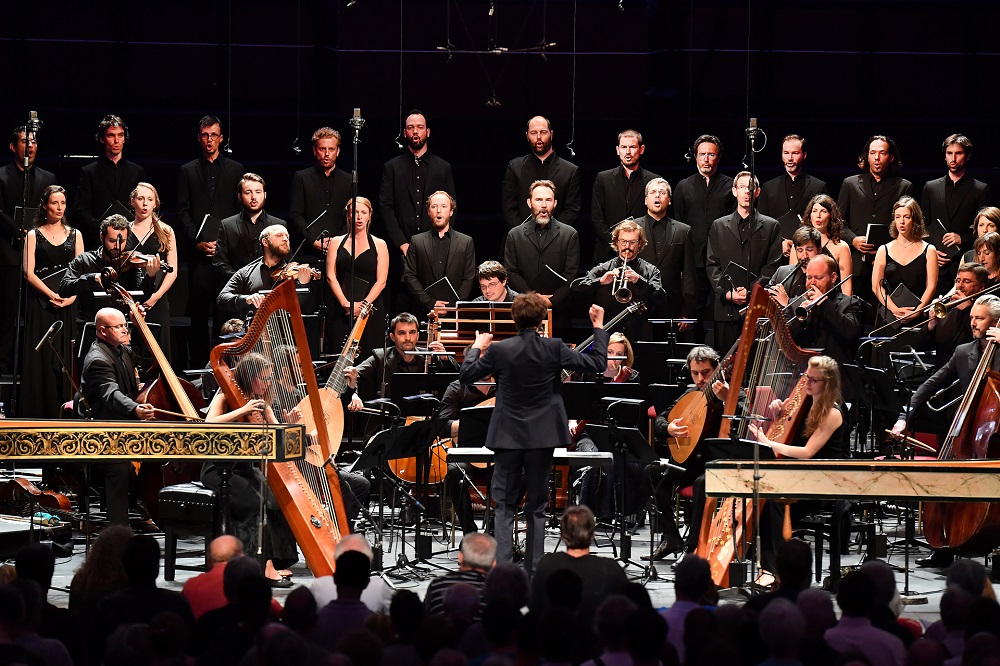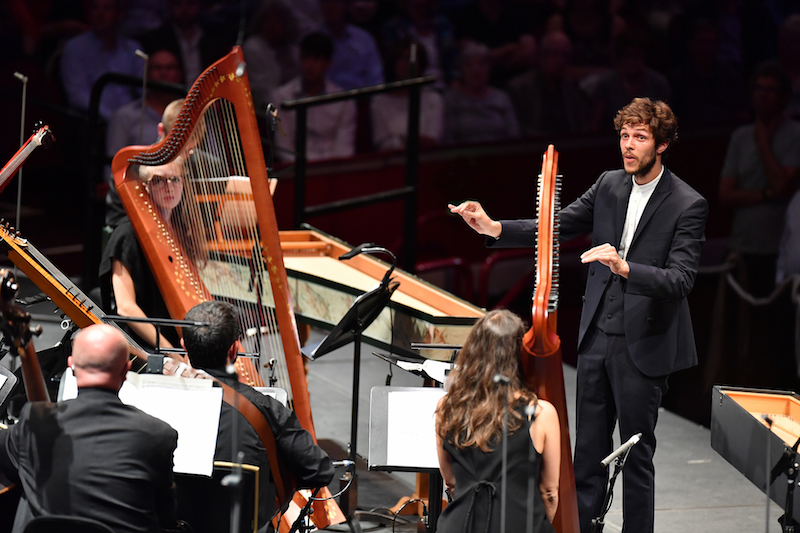Prom 22 review: Pygmalion, Pichon – theatrical take on Monteverdi's Vespers | reviews, news & interviews
Prom 22 review: Pygmalion, Pichon – theatrical take on Monteverdi's Vespers
Prom 22 review: Pygmalion, Pichon – theatrical take on Monteverdi's Vespers
Impressive young French conductor brings drama to Renaissance choral classic
As the lights dim the choir turn their backs on the audience. A spotlight picks out a single singer. With one hand aloft he leads the male voices through the “Pater Noster” and “Ave Maria” in a stern and stately plainchant. Then suddenly the full battalion of cornetts and sackbuts, theorbos and recorders burst into the joyful opening of Monteverdi’s Vespers, and we are up and running.
The Vespers, like Bach’s B Minor Mass, was not heard complete in the composer’s lifetime, and may indeed not even have been conceived to have been heard in a single sitting. As Bach did later, Monteverdi seems to have published the Vespers in 1610 as a professional calling-card, demonstrating his varied skills as a composer in order to promote himself on the job market. One way or another it did the trick since, soon after, he landed the plum job of director of music at St Mark’s in Venice.
The music itself spans a wide range, from polyphonic choral writing, to madrigal-like vocal textures and passages of almost operatic solo writing. To this mix Pichon added a further element: the interstitial plainchant that would have been expected in liturgical performances in Monteverdi’s time. This, he says, “gives a very different face to this piece: something more quiet and contemplative.” They also added some 20 minutes to the running time of the piece, as all the plainchant passages were taken at a crawling pace. While this worked in places – such as at the beginning – it was surprising, given the inventiveness evident elsewhere, that there wasn’t any diversity in approach here.
As ever with music of this type, there are many performance practice decisions to be made. The Pygmalion Ensemble played period instruments, and produced a wonderful array of sounds, including a watery, glistening passage for theorbos and harps in the "Nigra sum" movement. The choir was 35-strong, which is midway between the Andrew Parrott ideal of very small forces, and the massed choir approach. It seemed to balance well with the instruments, and the choir had, for the most part, clear diction and excellent ensemble.
Best of all were the two female soloists, dark-toned Giuseppina Bridelli and the lighter, brighter Eva Zaïcik, who did not blend, but matched each other beautifully in a number of rapturous duets. Pichon (pictured above) was understated and unshowy, keeping his gestures as small as possible, but always completely clear, always moving the music forward, impressively in control.
The final flourish was pure invention on Pichon’s part. After the end of the Magnificat, the usual end of the piece, he returned to the opening toccata, interspersed with more chant, offering a grander ending than Monteverdi provided. Where other decisions – such as the inclusion of chant – could seen as driven by the pursuit of authenticity, this seemed to be a gut feeling to end with a bang. And I can’t be sure Monteverdi wouldn’t have approved.
rating
Explore topics
Share this article
Add comment
The future of Arts Journalism
You can stop theartsdesk.com closing!
We urgently need financing to survive. Our fundraising drive has thus far raised £33,000 but we need to reach £100,000 or we will be forced to close. Please contribute here: https://gofund.me/c3f6033d
And if you can forward this information to anyone who might assist, we’d be grateful.

Subscribe to theartsdesk.com
Thank you for continuing to read our work on theartsdesk.com. For unlimited access to every article in its entirety, including our archive of more than 15,000 pieces, we're asking for £5 per month or £40 per year. We feel it's a very good deal, and hope you do too.
To take a subscription now simply click here.
And if you're looking for that extra gift for a friend or family member, why not treat them to a theartsdesk.com gift subscription?
more Classical music
 Classical CDs: Vitamins, kings and magic spells
A neglected ballet score, romantic piano concertos and contemporary British music
Classical CDs: Vitamins, kings and magic spells
A neglected ballet score, romantic piano concertos and contemporary British music
 Kavakos, Philharmonia, Blomstedt, RFH review - a supreme valediction forbidding mourning
Nonagenarian conductor provides the flow, his players the passion, in Mahler's Ninth
Kavakos, Philharmonia, Blomstedt, RFH review - a supreme valediction forbidding mourning
Nonagenarian conductor provides the flow, his players the passion, in Mahler's Ninth
 Perianes, Orchestre Symphonique de Montréal, Payare, Barbican review - elegance and drama but not enough bite
Often dynamic Venezuelan conductor misses the darkness of the 'Symphonie fantastique'
Perianes, Orchestre Symphonique de Montréal, Payare, Barbican review - elegance and drama but not enough bite
Often dynamic Venezuelan conductor misses the darkness of the 'Symphonie fantastique'
 La Serenissima, Wigmore Hall review - an Italian menu to savour
Tasty Baroque discoveries, tastefully delivered
La Serenissima, Wigmore Hall review - an Italian menu to savour
Tasty Baroque discoveries, tastefully delivered
 Roman Rabinovich, Wigmore Hall review - full tone in four styles
Fascinating Haydn, Debussy and Schumann, odd Beethoven
Roman Rabinovich, Wigmore Hall review - full tone in four styles
Fascinating Haydn, Debussy and Schumann, odd Beethoven
 Wyn, Dwyer, McAteer, RSNO & Choirs, Diakun, Usher Hall, Edinburgh review - ebullient but bitty
‘Carmina Burana’ is fun in parts, but Langer’s ‘Dong’ doesn’t flow
Wyn, Dwyer, McAteer, RSNO & Choirs, Diakun, Usher Hall, Edinburgh review - ebullient but bitty
‘Carmina Burana’ is fun in parts, but Langer’s ‘Dong’ doesn’t flow
 Gerhardt, BBC Philharmonic, Chauhan, Bridgewater Hall, Manchester review - from grief to peace
Anna Clyne, Shostakovich and Richard Strauss tell us about loss, struggle and healing
Gerhardt, BBC Philharmonic, Chauhan, Bridgewater Hall, Manchester review - from grief to peace
Anna Clyne, Shostakovich and Richard Strauss tell us about loss, struggle and healing
 First Person: Alec Frank-Gemmill on reasons for another recording of the Mozart horn concertos
On ignoring the composer's 'Basta, basta!' above the part for the original soloist
First Person: Alec Frank-Gemmill on reasons for another recording of the Mozart horn concertos
On ignoring the composer's 'Basta, basta!' above the part for the original soloist
 Mailley-Smith, Piccadilly Sinfonietta, St Mary-le-Strand review - music in a resurgent venue
Neglected London church now the home of a vibrant concert series
Mailley-Smith, Piccadilly Sinfonietta, St Mary-le-Strand review - music in a resurgent venue
Neglected London church now the home of a vibrant concert series
 Classical CDs: Mandolins, multiphonics and multiple pianos
Classical horn concertos, a Gallic record label celebrated and Seventies pop meets the French baroque
Classical CDs: Mandolins, multiphonics and multiple pianos
Classical horn concertos, a Gallic record label celebrated and Seventies pop meets the French baroque

Comments
Thought it was a thrilling
I disagree with Bernard only